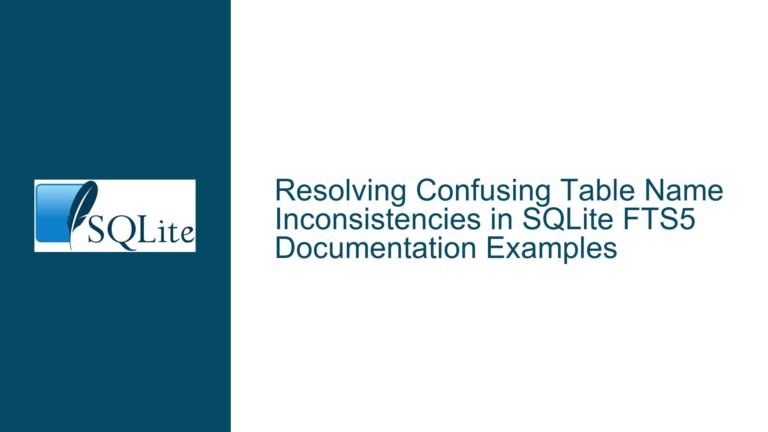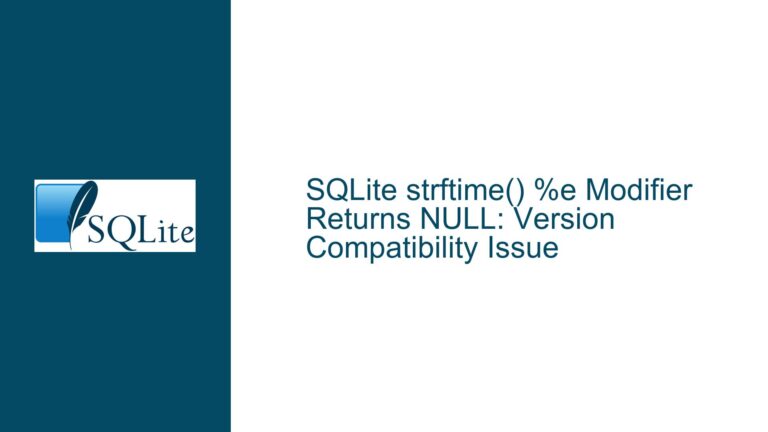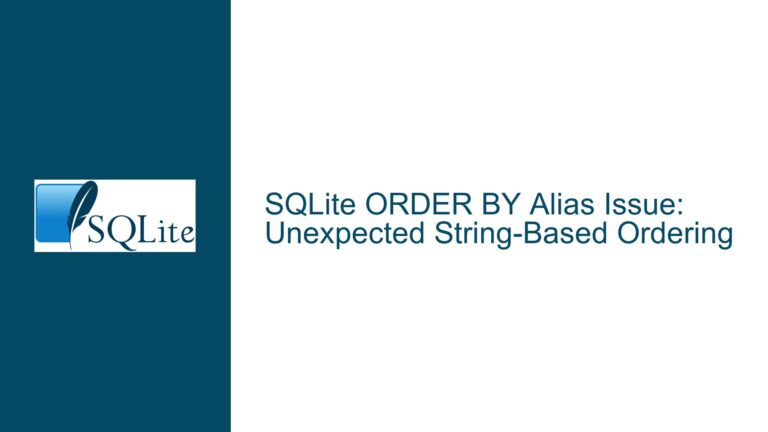FTS5 Tokenizer Issue with Left Half-Ring Character in Unicode61
FTS5 Tokenizer Fails to Match Left Half-Ring Character in Arabic Transliteration
The core issue revolves around the behavior of SQLite’s FTS5 (Full-Text Search) tokenizer when handling the left half-ring character (ʿ) in Arabic transliterated names. The Unicode61 tokenizer, which is the default tokenizer for FTS5, categorizes the left half-ring character as part of the "Lm" (Letter, Modifier) category. According to the Unicode61 tokenizer’s default configuration, characters in the "L*" category (which includes "Lm") are treated as token characters, meaning they are considered part of the word and not stripped during tokenization.
However, the observed behavior is that the FTS5 tokenizer does not match the left half-ring character when it is omitted from the search query. For example, a search for "Ajjal" does not return results that include "ʿAjjāl" unless the left half-ring character is explicitly included in the search term. This behavior is counterintuitive for users who expect the tokenizer to handle such characters in a way that aligns with common transliteration practices, where diacritical marks like the left half-ring are often optional or interchangeable in search queries.
The issue is particularly relevant for applications dealing with Arabic transliterated names, where the left half-ring character is frequently used to represent the Arabic letter "ayn" (ع). The expectation is that the tokenizer should either strip such characters during tokenization or treat them as optional in search queries. The current behavior forces users to include the left half-ring character in their search terms, which is not always practical or desirable.
Unicode61 Tokenizer Treats Left Half-Ring as Token Character
The root cause of this issue lies in how the Unicode61 tokenizer categorizes and processes characters. The Unicode61 tokenizer is designed to handle Unicode text by categorizing characters into different groups, such as letters, numbers, and punctuation marks. The default configuration for the tokenizer includes the "L*" category, which encompasses all Unicode letter categories, including "Lm" (Letter, Modifier). The left half-ring character (ʿ) falls under the "Lm" category, which means it is treated as a token character by default.
When the FTS5 tokenizer processes text, it generates tokens based on the characters’ categories. Characters in the "L*" category are included as part of the token, while characters in other categories, such as punctuation marks, are typically stripped. In the case of the left half-ring character, the tokenizer includes it as part of the token because it is categorized as a letter modifier. This behavior is consistent with the Unicode standard, which classifies the left half-ring character as a letter modifier.
However, this behavior is problematic for Arabic transliteration, where the left half-ring character is often used as a diacritical mark rather than a standalone letter. In many cases, users expect the tokenizer to either strip such characters or treat them as optional in search queries. The current implementation of the Unicode61 tokenizer does not provide an easy way to customize this behavior, leading to the observed issue where searches fail to match terms that include the left half-ring character unless it is explicitly included in the search query.
Another factor contributing to the issue is the lack of a built-in mechanism in the Unicode61 tokenizer to handle language-specific or script-specific tokenization rules. While the tokenizer is designed to be general-purpose, it does not account for the nuances of specific languages or scripts, such as Arabic transliteration. This limitation makes it difficult to achieve the desired behavior without resorting to custom tokenizers or preprocessing steps.
Custom Tokenizer or Preprocessing for Arabic Transliteration
To address the issue, users have several options, each with its own trade-offs. The most straightforward solution is to create a custom tokenizer that better handles the left half-ring character and other diacritical marks used in Arabic transliteration. A custom tokenizer could be designed to strip or ignore specific characters during tokenization, ensuring that search queries match the intended terms regardless of whether the diacritical marks are included.
Creating a custom tokenizer involves implementing a new tokenizer class in SQLite’s FTS5 extension. This class would need to override the default tokenization behavior to handle the left half-ring character and other relevant characters according to the desired rules. For example, the custom tokenizer could be designed to strip the left half-ring character during tokenization, effectively treating it as optional in search queries. This approach would require a deep understanding of SQLite’s FTS5 extension and the ability to write and compile custom C code.
Another option is to preprocess the text before feeding it into the FTS5 virtual table. Preprocessing could involve stripping or replacing the left half-ring character and other diacritical marks in the input text, effectively normalizing the text to a form that is more compatible with the default Unicode61 tokenizer. This approach avoids the need for a custom tokenizer but requires additional steps to ensure that the original text and the preprocessed text are kept in sync.
Preprocessing could be done at the application level, where the text is modified before being inserted into the database. Alternatively, it could be done using SQLite’s built-in functions, such as REPLACE or SUBSTR, to modify the text within the database. However, this approach has the drawback of requiring additional storage space, as the preprocessed text would need to be stored in a separate column or table.
A third option is to use a combination of preprocessing and custom tokenization. For example, the text could be preprocessed to remove or replace specific characters, and a custom tokenizer could be used to further refine the tokenization process. This approach provides the most flexibility but also requires the most effort to implement and maintain.
In conclusion, the issue with the FTS5 tokenizer and the left half-ring character in Arabic transliteration stems from the Unicode61 tokenizer’s treatment of the character as a token character. While this behavior is consistent with the Unicode standard, it is not ideal for Arabic transliteration, where the character is often used as a diacritical mark. To address the issue, users can create a custom tokenizer, preprocess the text, or use a combination of both approaches. Each solution has its own trade-offs, and the best approach depends on the specific requirements of the application.





